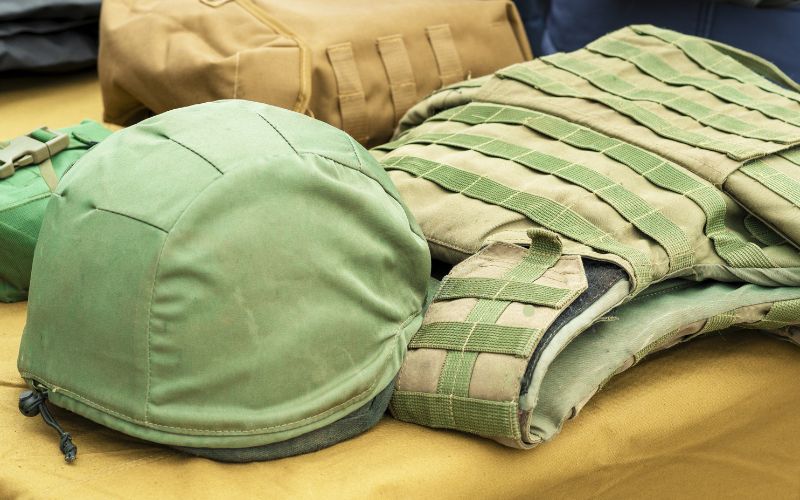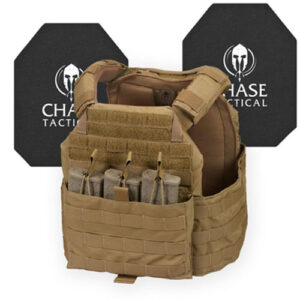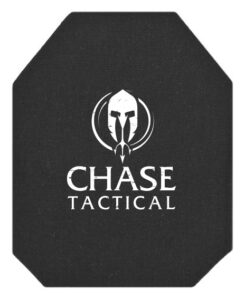Steel vs. Ceramic Body Armor: Which Is Right For You?

The debate between steel and ceramic body armor is heated in the world of personal protection. With advancements in technology and increasing threats, choosing the right body armor has never been more crucial. Whether in law enforcement, the military, or a civilian looking to enhance personal safety, understanding the differences between steel and ceramic body armor can help you make an informed decision.
Today’s blog will examine the pros and cons of steel body armor, helping you determine which best suits your needs.
Understanding Body Armor: A Brief Overview
Before discussing the specifics of steel and ceramic body armor, it’s important to understand its role in personal protection. Body armor protects the wearer from projectiles, typically bullets, by absorbing and dispersing the impact energy. It comes in various forms, from soft armor made of flexible materials like Kevlar to hard armor, which uses rigid plates made of steel, ceramic, or polyethylene.
The National Institute of Justice (NIJ) typically rated hard armor plates based on their ability to stop specific types of bullets at particular velocities. The most common ratings for hard armor are Level III and Level IV. Level III armor is designed to stop rifle rounds, while Level IV is tested to stop armor-piercing rounds. Both steel and ceramic plates can be made to meet these standards, but they do so in different ways.

Steel Body Armor
Steel body armor is hard armor made from specially treated steel plates. This traditional body armor has been used for decades for its strength and durability. The steel plates are designed to absorb and disperse the energy from bullets, preventing penetration and protecting the wearer from harm. Ultimately the best bulletproof body vest.
Advantages Of Steel Body Armor
Durability: Steel plates can withstand multiple hits without losing their protective capabilities, making them ideal for situations where repeated impacts are likely.
Cost-Effective: Steel armor is generally more affordable than ceramic, making it accessible to a broader range of users, including civilians and those on a budget.
Thin Profile: Steel plates have a thinner profile than ceramic plates, reducing bulk and allowing for greater mobility, especially when worn under clothing.
Reliable Protection: Steel armor is effective against various ballistic threats and provides solid protection against standard rifle rounds.
Disadvantages Of Steel Body Armor
Heavy Weight: Steel plates are significantly heavier than ceramic alternatives, which can lead to fatigue during prolonged use and reduce the wearer’s agility.
Limited Protection Against Armor-Piercing Rounds: Some high-velocity or armor-piercing rounds can penetrate steel armor, particularly if the body armor plates are not thick enough.
Corrosion Risk: Steel body armor is prone to rust and corrosion if not properly maintained, compromising its protective capabilities over time.
Ceramic Body Armor
Ceramic body armor is a modern alternative to steel armor. It is made from advanced ceramic materials like aluminum oxide, boron carbide, or silicon carbide. These plates are designed to shatter upon impact, dispersing the bullet’s energy and reducing the likelihood of penetration. Chase tactical ceramic armor is particularly valued for its lightweight design and superior protection against high-velocity rounds.

Advantages Of Ceramic Body Armor
Lightweight: Ceramic plates are much lighter than steel, reducing fatigue and improving comfort during extended wear. This makes them ideal for scenarios requiring high mobility and prolonged usage.
Superior Protection Against Armor-Piercing Rounds: Ceramic armor is highly effective against high-velocity and armor-piercing rounds due to its ability to shatter and absorb the energy of the impact.
Reduced Risk of Spalling: Unlike steel, ceramic plates do not produce dangerous fragments when struck by a bullet, making them safer for the wearer and those nearby.
Non-Corrosive: Ceramic materials do not rust or corrode, ensuring consistent protection without extensive maintenance.
Disadvantages Of Ceramic Body Armor
Thicker Profile: The thickness of ceramic plates is generally more than steel. Ceramic plates are generally thicker than steel, which can add bulk and reduce the wearer’s mobility and comfort, particularly when trying to conceal the armor.
Shorter Lifespan After Impact: Due to their fragility, ceramic plates may need to be replaced more frequently, especially after taking a hit, leading to additional costs over time.
Steel And Ceramic Body Armor Products Recommendations
For Ceramic Body Armor: Consider the 4S17M Level IV Rifle Armor Plates for high-performance ceramic armor. The plates are designed to stop advanced threats, including armor-piercing rounds, provide full coverage, and security, and offer lightweight protection and ergonomic comfort. They are durable enough to provide reliable performance in critical situations.
For Steel Body Armor: If you want steel, then the 3S14M Lightweight Rifle Plates offer good ballistic protection at a price. These plates are designed for durability and multi-hit capability with minimum weight to add mobility.
Comparing Steel And Ceramic Armor: Key Factors To Consider
When choosing between steel and ceramic body armor, several factors should be considered to ensure you select the best option for your needs. These factors include weight, how body armor works, durability, cost, protection level, and intended use.
Weight And Mobility
Ceramic armor is generally better if weight and mobility are your primary concerns. Its lighter weight and reduced bulk make it more comfortable to wear for extended periods, particularly in situations requiring high mobility. On the other hand, if you prioritize durability and the ability to withstand multiple hits, steel armor may be more suitable despite its added weight.
Durability And Longevity
Steel armor is unmatched in durability. Its ability to withstand multiple impacts without compromising its integrity makes it an excellent choice for scenarios where repeated hits are expected. Ceramic armor, while highly effective at stopping bullets, is more fragile and may need replacement after a single impact.
Threat Level
If you’re likely to face armor-piercing rounds, ceramic plates offer superior protection. For lower-caliber threats or prolonged engagements, steel may be sufficient and cost-effective.
Cost And Budget
Cost is often a significant factor in choosing body armor. Steel plates are generally more affordable, making them popular for those on a budget. However, it’s essential to weigh the cost against the level of protection and the specific threats you may face. While more expensive, ceramic plates offer superior protection against high-velocity and armor-piercing rounds.
Level Of Protection
The level of protection you need should also guide your decision. Ceramic armor is the better option if you are likely to face armor-piercing rounds because it can shatter and disperse the bullet’s energy. While effective against standard rifle rounds, steel armor may not protect against more advanced threats.
Intended Use
Finally, consider the context in which you will be using the armor. Military personnel and law enforcement officers facing high-threat situations may prefer ceramic armor for its advanced protection and lighter weight. Civilians or those in lower-risk environments may find steel armor a more practical and cost-effective option.
Steel vs. Ceramic: Which Should You Choose?
Select Steel If
- You are on a budget.
- You expect long engagements that require multi-hit capability.
- You are working in extreme environments where durability is key.
Select Ceramic If
- Mobility and weight are critical.
- You need protection against high-velocity or armor-piercing ammunition.
- Comfort and ergonomics are important for extended use.
Conclusion: Making The Right Choice
The selection of body armor hinges on a thorough assessment of specific requirements, anticipated threats, and financial considerations. Each material, whether steel or ceramic, presents distinct advantages and limitations that must be carefully scrutinized before deciding. By understanding the advantages and disadvantages of each material, you can make an informed decision that provides the best protection for your situation.
Frequently Asked Questions
What Offers Better Protection Than Steel Armor?
Ceramic plates are designed to stop armor-piercing rounds and high-caliber bullets, providing a higher level of protection than steel armor. They are particularly effective against threats that steel might not fully block, such as .30 caliber armor-piercing (AP) bullets and high-velocity rounds.
What Is The Best Material For Body Armor?
Steel and ceramic are two of the top choices for hard body armor. Both materials offer low backface deformation and are more affordable than polyethylene, making them excellent options for protection against rifle threats.
